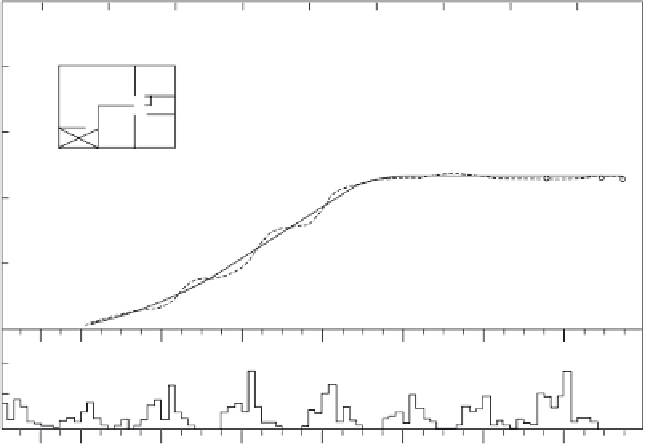Environmental Engineering Reference
In-Depth Information
25
A
=11.6 cms
B
av
=0.6 cms
t
1
=0.78 years
t
2
=4.00 years
6
8
7
20
5
10
9
15
3
2
4
t
2
10
5
t
1
10
5
1951
1952
1953
1954
1955
1956
1957
1958
FIGURE 10.43
Typical heave record of single-story brick house in Orange Free State gold fields. (From Jennings, J.E.,
Trans.
South African Inst. Civil Eng.,
1969. With permission.)
integrated and badly broken and microfissured from the weathering and expansion of clay
minerals. As a result, their shallower portions consist of a mass of hard fragments in a soil
matrix. The hard fragments can vary from a medium-hard rock (see
Figure 6.88,
Permian
shale from Goias, Brazil) to a very hard indurated clay (see Plate 5.15, a clay shale from
Santa Catarina, Brazil). Where the weathering is primarily mechanical from the swelling
of the clay minerals the disintegrated shale can be found extending downward nearly
from the surface, or where chemical weathering has dominated it can be found under a
residue of highly expansive clay.
Classification of these materials as either a residual soil (see
Section 7.2.3)
or a weathered
rock (see
Section 6.7.3)
is difficult because of their properties and characteristics. Clay and
marine shale are often described as soils in engineering articles and as rock in most geologic
publications. They are truly transitional materials, even referred to at times as claystone.
Example: Menlo Park, California
Project:
A large urban development suffered substantial and costly damage from the
expansion of clay shale (Meehan et al., 1975).
Geologic conditions:
Prior to development, the area was virgin hilly terrain underlain by
interbedded sandstone and claystone dipping typically at 40 to 60
. In the lower eleva-
tions, the claystones are overlain by 3 to 10 ft of black clayey residual or colluvial soils. The
weathered portions of the claystone are yellow to olive brown in color, becoming olive
gray in fresh rock. The fresh claystone, a soft rock, has two major joint systems, the mas-
ter system spaced at about 3 ft and the secondary system from 1 to 3 in. Groundwater is
generally about 30 ft below the surface. Typical claystone properties are:
°
Index properties: LL
70%, PI
20, Gs
2.86,
γ
t
135 pcf
●
Clay mineral: Montmorillonite
●
Swell pressures: Measured in the consolidometer, 4 to 9 tsf
●



